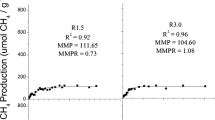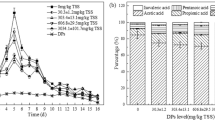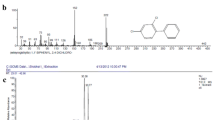Abstract
Of four chlorinated guaiacols, tetrachloroguaiacol at 62 μM inhibited acetate methanogenesis, the strongest decreasing activity by 50%. 4,5,6-Trichloroguaiacol, 4,5-dichloroguaiacol, and 4-chloroguaiacol showed 50% inhibition at 0.13, 0.32, and 1.50 mM, respectively. Degradation test results of volatile fatty acids (acetic, propionic, and butyric acid) by anaerobic digester sludge (stored 5 weeks) indicated that syntrophic butyrate degraders of this sludge were more sensitive to tetrachloroguaiacol than acetoclastic methanogens and syntrophic propionate degraders.
Similar content being viewed by others
References
Chu I,Villeneuve DC,Yagmanis AP,Valli VE (1979) Tri-and tetrachloroguaiacol: results of a three and six-month feeding study in rats. Arch. Environ. Contam. Toxicol. 8: 589-597.
Clescerl LS,Greenberg AE,Eaton AD (1998) Standard Methods for the Examination of Water and Wastewater. Washington: APHAAWWA-WEF.
Colleran E,Concannon F,Golden T,Geoghegan F,Crumlish B,Henry M,Coates J (1992) Use of methanogenic activity tests to characterize anaerobic sludges, screen for anaerobic biodegradability and determine toxicity thresholds against individual anaerobic trophic groups and species. Water Sci. Technol. 25: 31-40.
Ennik-Maarsen K,Louwerse A,Roelofsen W,Stams AJM (1998) Influence of monochlorophenols on methanogenic activity in granular sludge. Water Res. 32: 2977-2982.
Feijoo G,Vidal G,Moreira MT,Mendez R,Lema JM (1995) Degradation of high molecular weight compounds of kraft pulp mill effluents by a combined treatment with fungi and bacteria. Biotechnol. Lett. 17: 1261-1266.
Hwa CS,Lettinga G (1997) Acute toxicity of oleate to acetateutilizing methanogens in mesophilic and thermophilic anaerobic sludges. Enzyme Microbiol. Tech. 21: 297-301.
Kennedy CJ,Sweeting RM,Johansen JA,Farrell AP,McKeown BA (1996) Lethal and sublethal effects of chlorinated resin acids and chloroguaiacols in rainbow thout. In: Servos MR,Munkittrick KR,Carey JH,van der Kraak GJ, eds. Environmental Fate and Effects of Pulp and Paper Mill Effluents. Delray Beach: St. Lucie Press, pp. 391-400.
Landner L,Lindström K,Karlsson M,Nordin J,Sörensen L (1977) Bioaccumulation in fish of chlorinated phenols from kraft pulp in mill bleachery effluents. Bull. Environ. Contam. Toxicol. 18: 663-673.
Neilson AH,Allard AS,Reiland S,Remberger M,Tärnholm A,Viktor T,Landner L (1984) Tri-and tetra-chloroveratrole, metabolites produced by bacterial O-methylation of tri-and tetrachloroguaiacol: an assessment of their bioconcentration potential and their effects on fish reproduction. Can. J. Fish. Aquat. Sci. 41: 1502-1512.
Paasivirta J,Heinola K,Humppi T,Karjalainen A,Knuutinen J,Mäntykoski K,Paukku R,Piipola T,Surma-Aho K,Tarhanen J,Welling L,Vihonen H (1985) Polychlorinated phenols, guaiacols and catechols in environment. Chemosphere 14: 469-491.
Palm H,Paasivirta J,Lammi R (1995) Behaviour of chlorinated phenolic compounds in bleach-plant, treatment-system and archipelago area. Chemosphere 31: 2839-2852.
Renberg L,Svanberg O,Bengtsson BE,Sundtröm G (1980) Chlorinated guaiacols and catechols bioaccumulation potential in bleaks (Alburnus alburnus, Pisces) and reproductive toxic effects on the harpacticoid Nitocra spinipes (Crustacea). Chemosphere 9: 143-150.
Rintala JA,Puhakka JA (1994) Anaerobic treatment in pulp-and paper-mill waste management: a review. Bioresource Technol. 47: 1-18.
Salkinoja-Salonen MS,Valo R,Apajalahti J,Hakulinen R,Silakoski L,Jaakkola T (1984) Biodegradation of chlorophenolic compounds in waters from wood-processing industry. In: Klug MJ,Reddy CA, eds. Current Perspectives in Microbial Ecology. Washington: American Society for Microbiology, pp. 668-676.
Sanz JL,Rodriguez N,Amils R (1997) Effect of chlorinated aliphatic hydrocarbons on the acetoclastic methanogenic activity of granular sludge. Appl. Microbiol. Biotechnol. 47: 324-328.
Sierra-Alvarez R,Lettinga G (1991) The effect of aromatic structure on the inhibition of acetoclestic methanogenesis in granular sludge. Appl. Microbiol. Biotechnol. 34: 544-550.
Wang YT,Gabbard HD,Pai PC (1991) Inhibition acetate methanogenesis by phenols. J. Environ. Eng.-ASCE 117: 487-500.
Wu WM,Bhatnagar L,Zeikus JG (1993) Performance of anaerobic granules for degradation of pentachlorophenol. Appl. Environ. Microbiol. 59: 389-397.
Yin CR,Seo DI,Kim MK,Lee ST (2000) Inhibitory effect of hardwood lignin on acetate-utilizing methanogens in anaerobic digester sludge. Biotechnol. Lett. 22: 1531-1535.
Author information
Authors and Affiliations
Rights and permissions
About this article
Cite this article
Yin, CR., Seo, DI., Baek, SH. et al. Inhibitory effect of chlorinated guaiacols on methanogenic activity of anaerobic digester sludge. Biotechnology Letters 23, 1379–1383 (2001). https://doi.org/10.1023/A:1011644229246
Issue Date:
DOI: https://doi.org/10.1023/A:1011644229246




